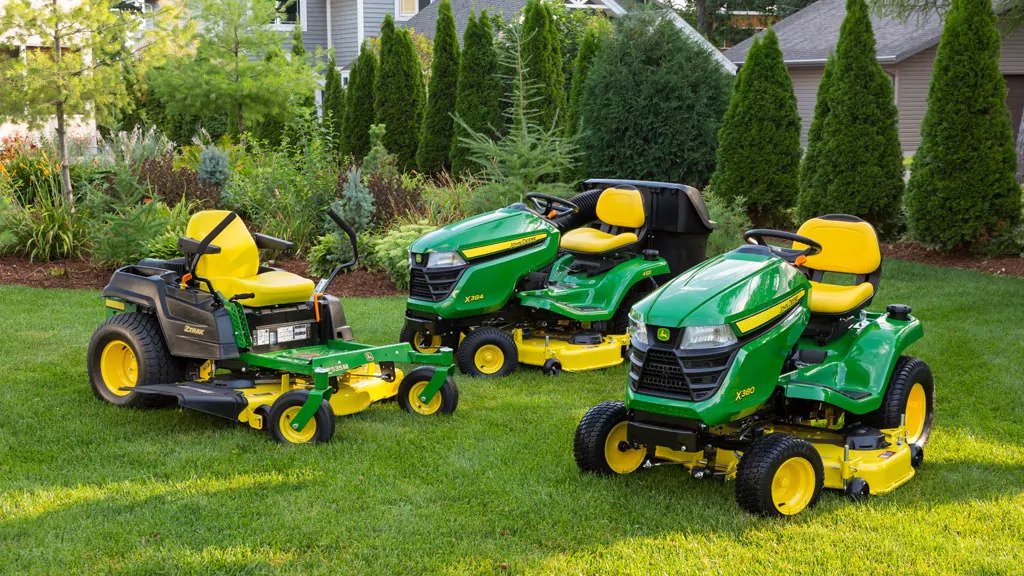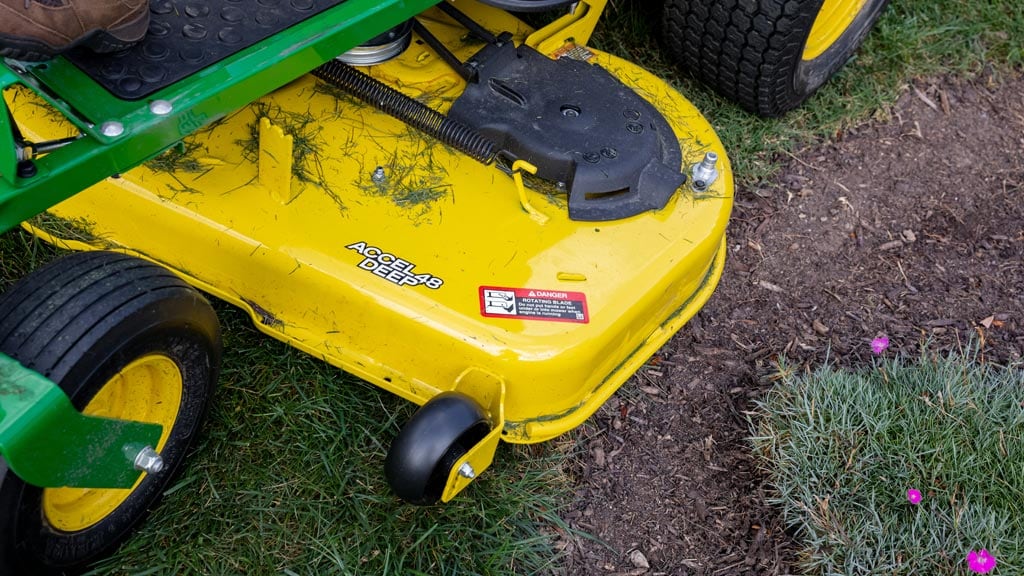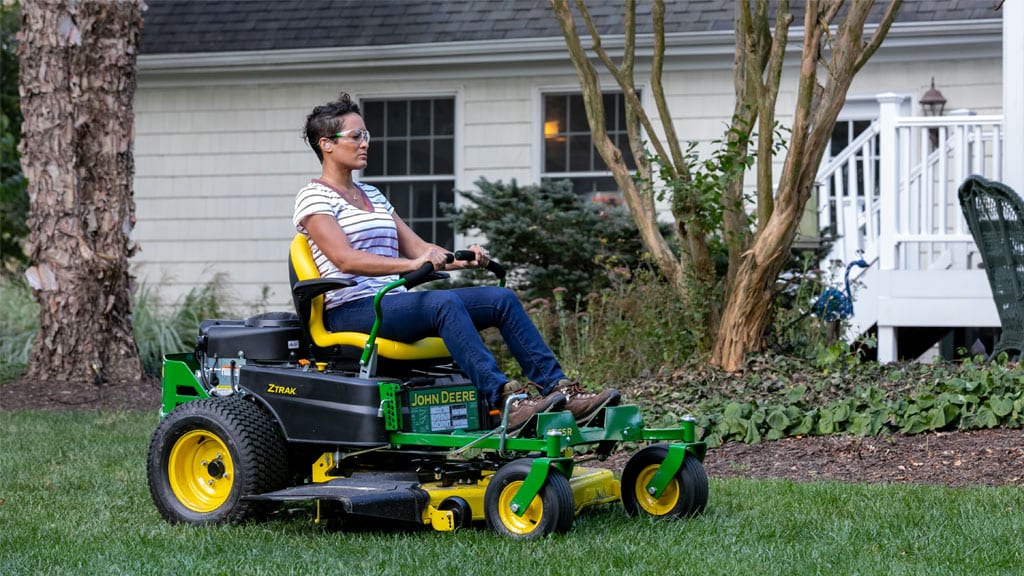

We may earn revenue from the products available on this page and participate in affiliate programs. Learn More ›
Lawns over half an acre give you plenty of space to play and lounge in the great outdoors. However, when it’s time to mow, you’re looking at a major commitment. Factor in landscaping like flower beds and trees, and you’ll likely add some trimming and spot mowing to your to-do list. The power machines of the landscaping world—zero turn vs. lawn tractor—can keep you from spending the better part of every Saturday behind a lawn mower.
A lot of factors go into determining which type of mower would be best suited for your lawn. Your yard’s size, incline, and landscaping all come into play. Before choosing between the two most common lawn mower types for large yards, get to know the biggest differences between zero-turn mowers and lawn tractors. This guide lays out the pros and cons of each to help you avoid making a mowing mistake with the wrong mower.
Zero-turn mowers are better for lawns with curves.
If your yard spans ½ an acre or more and is dotted with trees, bushes, and flower beds, a zero-turn mower will save you time when it comes to your lawn care routine. Zero-turn mowers have dual-hydrostatic transmissions controlled by two levers, which are key factors in their responsiveness and tight turning radius.
To move forward in a straight line, you press both levers forward, making sure to keep them even. To turn the mower, you either slow or stop power to one side by pulling the lever back, while the other side continues to move forward, giving the mower the ability to do a zero (or near zero) radius turn. This gives zero-turn mowers a mowing pattern that leaves far fewer missed patches of grass at the end of the swath or around curves and corners.
In comparison, lawn tractors have a wide turn radius, which leaves a patch of grass at the end of every swath. You can either come back around on a second pass to get those missed patches or stop and reverse to cut every blade of grass.

Lawn tractors power over slopes and hills.
Lawn tractors have a front-wheel drive that allows them to inch up slopes and hills with relative ease. In contrast, a zero-turn mower’s rear-wheel drive may be difficult to control or lose traction on uneven ground.
However, a word of caution: Both types of mowers can tip over on extreme slopes, which is anything over 15 degrees. Some lawn tractors and zero-turn mowers have roll bars and seat belts, but you’re better off using a push mower or a trimmer on extreme slopes.
A lawn tractor’s steering wheel provides intuitive control.
For those who want to jump on the lawn mower and go, a lawn tractor’s familiar steering wheel and gas pedal will take little if any time to get used to. Basically, you push the gas pedal and go, just like you would in a car. When you want to slow down, you release the gas and press the brake.
The differential speed control offered by a zero-turn machine’s dual-hydrostatic transmission, on the other hand, can take some practice. On these models, you control the speed by pressing the control levers forward rather than using a foot pedal. Hydrostatic transmissions can be touchy, so there may be some lurching and sudden stops until you get a feel for the speed control.
You also have to learn how to time the manipulation of the levers (one pressing forward, the other pulling back) when making turns. Considering that zero-turn mowers can go faster than lawn tractors as well means you’ll be trying to learn how to control the machine at higher speeds.
If you’re nervous about controlling a zero-turn model, a few newer machines have joystick control, which is much easier to use but still requires practice to master.

Deck size makes a difference, but the winner will depend on your yard.
The wider the deck, the fewer swaths it will take to cover the lawn, and the faster you can mow your full property. Lawn tractors have decks that range from 42 to 54 inches, while zero-turn mowers have decks from 42 to over 60 inches.
Choosing the appropriate deck size (and the mower or tractor that provides it) not only involves considering the size of your yard but also the width of the narrowest spaces you’ll need to mow in between or around. To maintain tight spaces between trees or flower beds, you’ll need a narrower deck. However, if you have a flat yard that’s 2 or 3 acres without obstacles, choose the machine with the widest deck you can afford.
Zero-turn mowers go faster, but slower speeds leave a cleaner cut.
Zero-turn mowers offer clean cuts at 5 miles per hour (mph) and can reach speeds of more than 10 mph. In comparison, lawn tractors mow at about 4 mph with a top speed of around 7 mph. However, in some circumstances, such as on sloped or hilly terrain, lawn tractors may be able to maintain their traction and speed better and, therefore, may occasionally mow faster under certain circumstances.
Know that cut quality goes down the faster you mow, whether you’re on a zero-turn or lawn tractor. Even if you have a zero-turn mower, the top speeds are generally used for traveling to another part of the yard rather than actually mow the lawn.

Both types of mowers are pricey, but zero-turn models rise to the top.
When it comes to price—zero turn vs. lawn tractors—both top the price charts. However, lawn tractors are the more affordable of the two, and they’ll earn their keep. They may also be used to pull carts, sprayers, spreaders, and other yard equipment. For the right buyer, a lawn tractor may be a smart investment. A base model starts around $1,200, but any extra accessories like a bagging kit, trailer, or sprayers must be purchased separately.
Zero-turn mowers start around $2,500 and go well above $5,000, and you may have to buy a bagging kit separately. If your yard spans several acres and/or has a wide range of trees and flowers you need to mow around, a zero-turn model may be well worth it for the time it saves.
